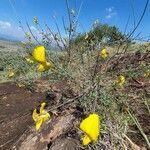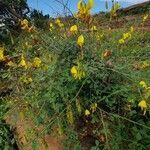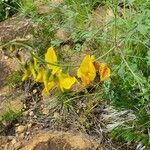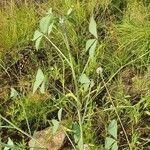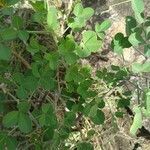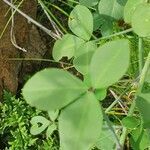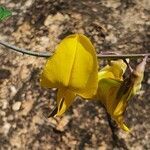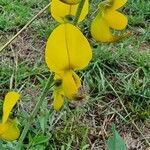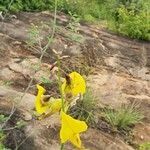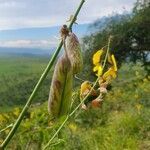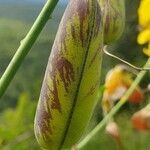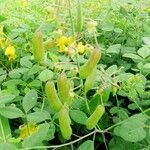Erect scarcely woody bushy herb, 0.6-2 m tall, with glabrous or thinly pubescent branches. Leaves 3-foliolate; leaflets variable, narrowly oblong to elliptic or elliptic-obovate, bluntly pointed to rounded or retuse at the apex, mostly 1-10.5 x 0.5-5.5 cm, glabrous or pubescent on the lower or on both surfaces; petiole usually longer than the leaflets. Stipules absent. Racemes lax, usually many-flowered; bracts linear or subulate, up to 4 mm long; bracteoles small. Calyx 1.2 1.7 cm long, glabrous to sparsely puberulous; upper and lateral lobes on either side sometimes coherent in young flowers, becoming free, narrowly attenuate-triangular. Standard ovate, yellow, often marked red-brown outside; wings little over half to three-fourths as long as the keel; keel strongly rounded, ± straight along the upper margin, abruptly contracted into a straight upwardly directed truncate beak, 2-3 cm long, often flecked or flushed maroon. Legume oblong-clavate to subcylindrical, with the 1.7-9.5 cm long stipe 4.5-15 cm long, glabrous, often mottled when young. Seeds oblique-cordiform, 4-5 mm long, granulate, ochre or brown.
An upright perennial plant. It is an evergreen shrub. It grows about 2 m tall. The leaves are yellowish-green. They have 3 leaflets. The leaflets are 3-5 cm long. The flowers are pea like with a light green keel and yellow standard. The fruit are yellow-brown pods. They are 3-15 cm long by 1 cm wide. There are 10-42 seeds that are orange-brown. They are 3-7 mm long.
Standard ovate, yellow, often marked red-brown outside; wings little over half to three quarters length of keel; keel 2–3 cm long, strongly rounded, ± straight along upper margin, abruptly contracted into a subtruncate upwardly directed beak, often flecked or flushed maroon.
Leaves 3-foliolate, estipulate; leaflets variable, 1–10.5 × 0.5–5.5 cm, narrowly oblong to elliptic or elliptic-obovate, bluntly pointed to rounded or retuse at apex, glabrous or pubescent; petiole usually longer than leaflets.
Calyx plus funnel-shaped hypanthium 1.2–1.7 cm long, glabrous to sparsely puberulous; lobes attenuate-triangular, longer than the tube.
Pod including the 1.7–9.5 cm long stipe up to 4.5–15 cm long, oblong-clavate to subcylindrical, glabrous, often mottled when young.
Racemes lax, usually many-flowered; bracts up to 4 mm long, linear or subulate; bracteoles small.
Erect scarcely woody bushy herb, 0.6–2 m tall, with glabrous or thinly pubescent branches.
Seeds 4–5 mm long, oblique-cordiform, granulate, ochre or brown.
